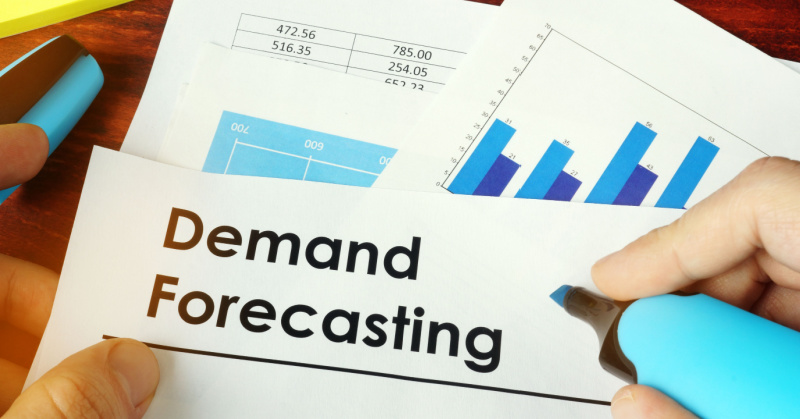Demand forecasting is a strategic imperative for businesses navigating today's marketplace. Because of supply chains across the globe, ever-changing customer preferences, and technology advancements, demand forecasting is a key tool for successful supply chain management.
For accountants, the challenge lies in maintaining financial accuracy and making data-driven decisions to optimize every aspect of the supply chain.
In this article, we will take a look at the intricacies of demand forecasting, explore its role in the modern supply chain, and equip you with the knowledge and tools needed to help your manufacturing clients navigate it effectively.
What is Demand Forecasting?
Demand forecasting is the process of predicting future customer demand for a product or service.
It involves estimating how much of a product or service customers will likely purchase over a specific period, typically in the near or distant future, using:
- Historical data
- Market analysis
- Various statistical and analytical methods
Why is Demand Forecasting Important?
Demand forecasting is crucial to help businesses make informed decisions related to:
- Production
- Inventory management
- Procurement
- Overall supply chain planning
Accurate demand forecasting can lead to:
- More efficient operations
- Reduced costs
- Improved customer service
- Better resource allocation
Effective planning based on demand forecasts enables businesses to align their production schedules with actual customer needs, reducing overproduction or stockouts.
Inventory management becomes more precise, minimizing excess inventory and associated carrying costs. Moreover, supply chain optimization allows businesses to streamline their procurement processes and distribution networks.
Accurate forecasts benefit financial planning and budgeting, enabling companies to allocate resources effectively and minimize wasteful spending.
Ultimately, customer service and satisfaction are enhanced as businesses consistently meet customer demands and expectations, leading to greater loyalty and long-term success.
Methods for Demand Forecasting
- Demand forecasting methods use either quantitative or qualitative techniques to predict future customer demand.
- Quantitative methods use historical data, mathematical models, and statistical analysis to make predictions.
- Qualitative methods involve expert opinions, market research, and subjective assessments to forecast demand based on non-numeric factors.
The choice of method often depends on the availability of data, the nature of the product or service, and the accuracy required for effective demand planning.
Qualitative Demand Forecasting Methods
Expert Opinion
Expert opinion in forecasting involves seeking insights from industry experts through structured interviews or surveys. These experts use their knowledge and experience to provide subjective assessments of future demand.
This method is especially useful when historical data is scarce or when external factors are challenging to quantify. However, these are opinions, meaning they are often complemented with quantitative forecasting methods to ensure accuracy.
Marketing Research
Market research involves gathering and analyzing data about:
- A specific market
- Customers
- Competitors
- Trends
It provides valuable insights into consumer behavior, preferences, and buying habits, enabling businesses to make more accurate predictions about future demand for their products or services.
Market research can be a vital tool for optimizing operations and decision-making when it comes to demand forecasting.
Quantitative Demand Forecasting Methods
Time Series Analysis
Time series analysis is a quantitative method that relies on historical data collected at regular intervals to predict future demand. It involves:
- Visualizing data
- Decomposing it into trends
- Seasonality
- Noise components
- Selecting an appropriate forecasting model
- Estimating model parameters
- Generating forecasts
This method is effective for short to medium-term predictions and helps businesses make informed decisions about production, inventory management, and supply chain strategies based on past data patterns.
Moving Averages
Moving averages smooth out fluctuations in historical data and identify underlying trends. This technique involves calculating the average of a specified number of recent data points, known as the "window size," to create a moving average value.
By plotting these moving averages on a graph, businesses can gain insights into long-term demand trends, helping them anticipate whether demand is:
- Increasing
- Decreasing
- Staying stable
While moving averages are valuable for filtering out noise in data, they may not respond rapidly to sudden demand shifts and are best suited for regular or slowly changing demand patterns.
Exponential Smoothing
Exponential smoothing assigns different weights to historical data points to create forecasts. It uses a smoothing factor (alpha) to balance responsiveness to recent changes and stability.
- A higher alpha gives more weight to current data, making the forecast responsive to changes.
- A lower alpha provides a smoother, more stable forecast.
Exponential smoothing is effective for adapting to changing demand patterns. It can be extended to handle seasonality and trend components in the data through methods like Holt-Winters.
It is valuable for businesses aiming to make forecasts that consider both short-term and long-term patterns in demand.
Regression Analysis
Regression analysis establishes statistical relationships between demand (the dependent variable) and potential influencing factors (independent variables). By analyzing historical data, regression models estimate coefficients that quantify how changes in these factors impact demand.
This method allows businesses to make data-driven predictions about future demand based on variables such as:
- Price
- Marketing
- Economic conditions
Ongoing monitoring and updating of the model ensures its accuracy and relevance as new data becomes available, helping companies optimize various aspects of their operations to effectively meet anticipated changes in demand.
Machine Learning
Machine learning involves using algorithms and statistical models to analyze historical data and predict future demand for products or services. It encompasses:
- Data collection
- Preprocessing
- Model selection
- Training
- Validation
- Continuous improvement
Machine learning models can handle large datasets, capture complex relationships, and adapt to changing patterns, offering more accurate and granular forecasts. However, they require expertise in data preparation and model selection and may need help in interpretability.
Ultimately, machine learning enhances demand forecasting by optimizing inventory management, reducing costs, and improving customer satisfaction through data-driven predictions.
Utilize Demand Forecasting for Inventory Optimization
Accurate demand predictions empower organizations to optimize inventory management. In the current landscape of dynamic markets and evolving consumer preferences, the importance of streamlined inventory management and data-driven demand forecasting cannot be overstated for businesses. Advanced tools in this field enable organizations to make well-informed decisions, swiftly adapt to changing market conditions, and proactively anticipate customer demands.
Embracing these technologies transforms operations, allowing businesses to operate more efficiently and effectively. This approach is vital for staying competitive and delivering exceptional value to customers, demonstrating the power of technology in enhancing business responsiveness and strategic planning.
.png?width=150&height=63&name=TWRlogo-regmark_blueblack%20(1).png)
.png)










Do you have questions about this article? Email us and let us know > info@woodard.com
Comments: